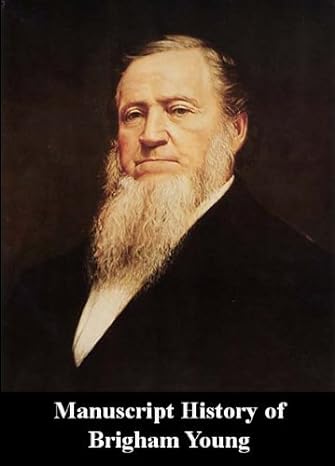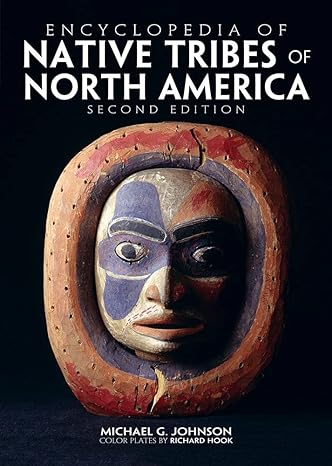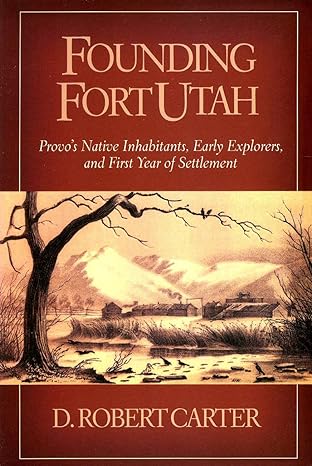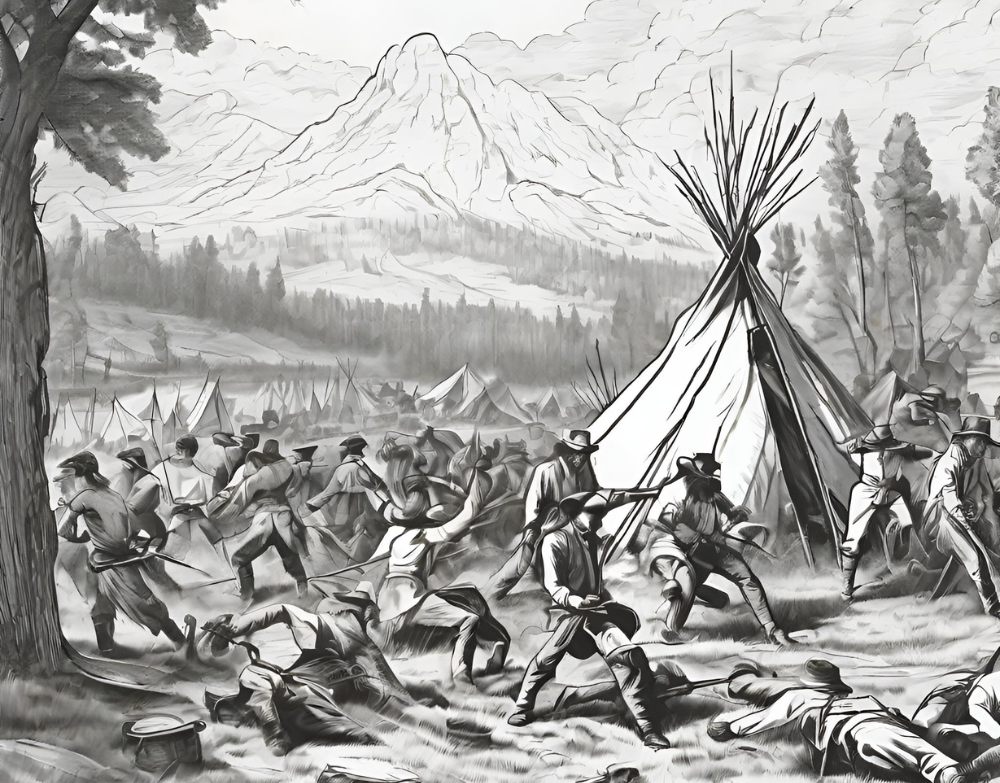Within a few decades of Mormon Pioneers colonizing the Utah territory, about 20,000 indigenous people were either killed, enslaved or permanently displaced with the blessing of the Church of Jesus Christ of Latter-Day Saints and its leaders. Those are the estimates according to US Federal data of the 1800s which is widely known to greatly under-estimate indigenous populations.
It’s easy to predict what LDS leaders say today about the history of Mormon-Indigenous relations since the colonizers arrived in 1847. Every organization in America, including the Church of Jesus Christ of Latter-Day Saints is entitled to a PR department, and every PR department’s main goal is reputation management.
When you Google the topic of LDS-Indian Relations, the first LDS-Church-sponsored Google Result you see (as of today at least) is an explanation of “Lamanite Identity.” For those already intimately familiar with the Book of Mormon narrative of the Lamanites and the Mormon beliefs about the indigenous people of America, I invite you to skip the next paragraph below. It’s necessary to explain this vital piece of background to understand how Mormon Leaders like Brigham Young and George Albert Smith didn’t bat an eye to the extermination and enslavement of Utah natives.
Book of Mormon Narrative of Indigenous Peoples of America
Briefly, the cliff-notes version of the Book of Mormon is that a family from Israel and a few others travelled from Jerusalem to the Americas around 600 BC. These people grew into two nations: Nephites and Lamanites. The Nephites are usually the righteous people, worshiping Christ long before… Christianity. The Lamanites were mostly lazy and disobedient, and so were cursed (according to the Book of Mormon) with dark skin. The Book of Mormon narrative continues for over 1000 years during which these two great nations fill the American continent. The narrative ends with a massive war where the entire Nephite civilization is wiped out. Iron, horses, chariots and other European-style descriptions of war ensue (although to date there is zero evidence that any ancient American culture had knowledge of iron, and they definitely did not have horses or chariots, but that’s for a different article). In the end, the Lamanites are the last ones standing and continue living “in spiritual darkness” until white colonizers arrive a century later to bring Christianity back. The book, invented by a man named Joseph Smith, is largely based on the pseudo-anthro-pulp: View of the Hebrews by Ethan Smith (no relation to Joseph) that was hugely popular at the time. Countless peer-reviewed DNA studies have never found any correlation between the indigenous people of the American Continent and Israel.
As you read about the atrocities ordered by Brigham Young on the indigenous people, it may all be difficult to believe, but with the understanding of how early Mormons believed that a dark skin color was a literal sign of the person’s moral failings, it becomes a bit easier to understand how this and other religious sects were able to justify genocide so freely and easily. It’s also important to note that during the decades of indigenous extermination in Utah, several individuals amongst the Mormons (many have remained unnamed and only mentioned in history books) took action to protect their indigenous neighbors during these attacks. Although the LDS Church’s official policy was to remove every Indian from the territory, the kindness and mercy of some Mormons is also an important part of the story.
Why Brigham Young Ordered the Extermination of the Timpanogos People
At the time Brigham Young and his wagons first entered the area we know as Utah in 1847, the Timpanogos People were the first prominent tribe that began to see their resources consumed by the Mormon Pioneers. Before the Mormons had arrived, the Timpanogos had already met with European explorers, mostly the Spanish Franciscan missionaries. This however was the first time the intruders made permanent settlements in the Salt Lake Valley where several indigenous nations hunted and gathered to prepare for the winter. Lumber, hunting grounds, water from natural springs and other essential resources suddenly disappeared. The fragile ecosystem that had fed the indigenous people over the last 10,000 years was turned upside-down in the space of 2 years.
The Timpanogos people in desperation began to steal cattle from the settlers to survive and in February of 1849 made the mistake of taking a cow from Brigham Young’s herd. Brigham Young’s immediate response in retaliation to the lost cattle was the complete extermination of the Timpanogos people.

Read Brigham Young’s own account of ordering the extermination of the Timpanogos people in the Manuscript History of Brigham Young, written by himself.
Battle Creek Massacre Begins Mormon-led Genocide of Indians
The LDS-Church-ordained massacre of the Timpanogos People is known today as the Battle Creek Massacre. Battle Creek still exists today in the (ironically-named) town of Pleasant Grove, Utah and one can hike the steep trail that follows a dry creek (which is wet in the spring and early summer). Brigham Young ordered 35 men to “convince” the Timpanogos to stop stealing cattle and to “take such measures as would put a final end to their depredations in future.” Reference: Manuscript History of Brigham Young
There was no attempt at civil or diplomatic relief to the growing tensions. The Mormon team arrived and immediately encircled the Timpanogos camp and called out for them to surrender. The Timpanogos refused and called out to be left alone.
Unprovoked gunfire from the Mormons rang out and the divided militia sprang into chaotic action. The initial gunfire took the life of Timpanogos leader of the encampment. At least seven other Timpanogos men were killed and a pursuit began as women and children scattered into the forest.
One anecdote as told from the perspective of the Mormon leader present at the massacre (Dimick B. Huntington) tells the story of a Timpanogos family that was caught up in the sudden violence and attempted to escape while holding an unloaded gun that they owned. They were overtaken by militiamen on horses and the eldest boy of the family remained hidden in a thicket. Huntington (able to speak in the Ute language) convinced the mother that the family would be safe if the boy would come out with the gun. The mother convinced her son to emerge and hand over their gun. They knew that their eventual fate would be to become slaves and several family members attempted to flee. Huntington and his men caught and slaughtered the unarmed runners on the spot.
Back at the encampment, the majority of women and children scattered into the surrounding woods and gathered in a hidden part of the cold mountain creek partially submerged in order to remain undetected of the Mormon militiamen that hunted for them and some of them perished from hypothermia.
The remaining women and children were caught and brought back to Salt Lake Valley as slaves. According to an 1850 count (a year after the massacre), at least 23 Timpanogos women and children were categorized as slaves residing in Salt Lake City. The fate of most of the other people taken from this encampment is largely unknown since Utah Saints were active in the Indian Slave trade, and it’s likely that many unnamed prisoners were sold off to farmers and ranchers throughout the western territories in a matter of months.

Highly Recommended
A must-have for anyone interested in the history of the indigenous peoples of the American continent:
Encyclopedia of Native Tribes of North America
Shortly after the massacre, Brigham Young ordered over 100 members of the LDS church to move down into the area we call Utah Valley (cities of Lehi down through Spanish Fork) and create settlements on the land that was recently occupied by the slain Timpanogos group in order to push any surviving members of the clan out of the valley permanently. There was no other reason for the settlers to claim this vast amount of land since land in the Salt Lake Valley was still quite plentiful (only having inhabited the land for 2 years).
The Illegal Settlements on Timpanogos Sacred Lands
When the Mormon Settlers sent by Brigham Young (shortly after the massacres) encountered the Timpanogos on their way to settle what we call today Utah Valley, they were stopped by Timpanogos warriors who said that the Mormon settlers were no longer welcome on their lands, the Timpanogos being a peace-loving people. Dimick Huntington swore on the Timpanogos Sun God that the LDS would be peaceful and would not harm any more Timpanogos. This sacred act to the natives meant that the Mormons would keep their word, and they let the Mormon Settlers through.
The Mormons built a reinforced stockade called Fort Utah and built the fort in an area that was considered by the Timpanogos to be off limits to settle on because of the trout runs in the summer. Furthermore, the Timpanogos considered the area to be sacred grounds that were set aside for an annual fish festival that the tribe held on Provo river (a river still world-famous as a trout fishing destination). Timpanogos travelled from many miles away each year to participate in the Festival– Timpanogos from as far as what we call Sanpete County (city of Ephraim).
Mormon settlers proceeded to fence off the land, change game trail patterns, and built on top of a berry field that the Timpanogos had used to gather food for thousands of years according to their own folklore.
Murder of a Timpanog named Old Bishop
That year in the late summer, three Mormon settlers named Rufus Stoddard, Richard Ivie, and Gerome Zabrisky murdered a native man named Old Bishop because they wanted his shirt. Old Bishop was also one of the only indigenous people that was loudly outspoken about the Mormons breaking their promise to not hunt game, a promise which the Mormons had given in exchange for a promise from the Timpanogos to stop stealing cattle.
Instead of resorting to violence, the Timpanogos tribe asked Mormon leaders for material recompense for the death of Old Bishop and Brigham Young refused. Instead, he ordered the men at Fort Utah to “have dominion” over the Timpanogos people. Tensions of course rose from there. Soon, Isaac Higbee (Bishop of Fort Utah) implored the LDS Church leadership Brigham Young, Daniel H. Wells and the First Presidency of the Quorum of the Twelve Apostles of the Church of Jesus Christ of Latter-Day Saints to proactively attack and exterminate the Timpanogos people before any harm came to the Fort Utah settlers. The decision to carry out an attack was swift and 3 days later on February 2nd, 1850, Brigham Young announced the plan to attack in a general assembly of the Church of Jesus Christ of Latter-Day Saints where he recruited a militia that left the next day to exterminate any “misbehaving indian.” This meeting is today considered the first official church-sanctioned and openly public call for the genocide of the Timpanogos People, although closed-door planning for it amongst the First Presidency and Quorum of the Twelve Apostles of the LDS Church (also the government and militia leaders) is recorded to have gone on at least a year prior to February 2nd 1850. The Battle Creek Massacre was not just an anomaly or a skirmish that arose between two military groups (the Timpanogos were a peaceful non-militaristic tribe), it was part of a wider pre-meditated effort over multiple years to make sure all Timpanogos men that did not comply were killed, and their women/children survivors sold through the slave trade of Salt Lake City.

A Must-read to learn about the history and ultimate fate of the Timpanogos people of the Provo River: Founding Fort Utah.
Provo River Massacre Increases Death Toll of Natives by 20 Fold in 2 days
The Timpanogos people got wind of the attack through friendly white settlers and began preparing by reinforcing an abandoned log cabin, and many Timpanogos that were friendly to Mormons found shelter within Fort Utah.
The first day of the attack ended in a stalemate, but in the second day the Mormon militia killed 10 Timpanog warriors and the rest fled. A few more skirmishes resulted in another 8 dead Timpanogos and 1 dead Mormon militiaman.
Brigham Young, on February 8th upon hearing of the death of the Mormon militiaman, ordered the total extermination of the Timpanogos saying: “I want every Indian out.” Reference: Founding Fort Utah.
The militia acted quickly and surrounded a settlement of Timpanogos families that were completely taken by surprise that cold winter morning. During a two-day period they systematically murdered an estimated 100 men, women and children. Estimates by the US government tend to under-estimate events where the only surviving witnesses are the perpetrators. Scholars estimate 3 – 5 times the size of casualties when studying a combination of historical sources. These estimates also don’t account for widespread violence that was likely taking place in more remote areas of Utah and never officially documented. Since Timpanogos did not have official birth and death records, and since there is no known resurgence of Timpanogos people, we can only imagine today that these Church-ordained mass killings were more wide-spread than is currently known.
In Part 2, we will discuss the Paiute who were preyed on by Mormon Settlers, Mexican traders and other indigenous nations and were perhaps the largest victims of the LDS Slave Trade in Salt Lake City, Utah.


